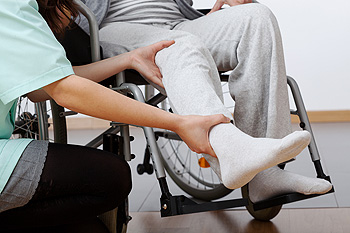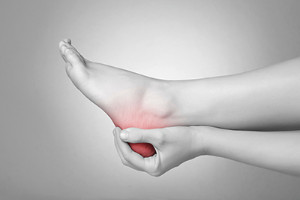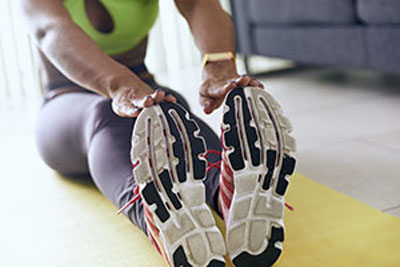Glen Allen Office
(804) 747-3380
 If an injury should occur to the foot or ankle, foot therapy may be an avenue that is pursued to obtain mild relief. There are many foot conditions that would benefit from having physical therapy performed, and these may include plantar fasciitis, or foot and ankle stress fractures. Some patients find it helpful to use this form of therapy to aid in recovering from foot or ankle surgery, and it may help in regaining full range of motion. Additionally, flexibility and overall strength in the feet and ankles may improve when specific muscles are stretched. If you would like to know more about the benefits of foot therapy, please consult with a podiatrist who can properly guide you.
If an injury should occur to the foot or ankle, foot therapy may be an avenue that is pursued to obtain mild relief. There are many foot conditions that would benefit from having physical therapy performed, and these may include plantar fasciitis, or foot and ankle stress fractures. Some patients find it helpful to use this form of therapy to aid in recovering from foot or ankle surgery, and it may help in regaining full range of motion. Additionally, flexibility and overall strength in the feet and ankles may improve when specific muscles are stretched. If you would like to know more about the benefits of foot therapy, please consult with a podiatrist who can properly guide you.
Foot therapy is often necessary for those recovering from either foot deformities or foot injuries. If you have concerns regarding therapy, consult with one of our podiatrists from The Podiatry Center. Our doctors can provide the care you need to keep you pain-free and on your feet.
Most Common Injuries
People who are active or athletes are prone to a variety of injuries. Therefore, it is often important to take part in physical therapy in order to quickly get back on the right track.
What to Do When Injured
Physical Therapy – This specialized treatment will focus on the affected area, speeding up recovery and the overall healing process. It is a proven method that has helped millions of people return from any injury.
During physical therapy you will undergo regimented training to get back into full form. Training is often very difficult, especially at first when the foot feels weak. Physical therapy often involves:
Basic stretching and twisting exercises – getting the feet’s mobility and flexibility up.
Massaging – the therapist will massage the injured area in order to activate the muscles and relax them.
Strengthening Exercises – this allows the muscles in the affected area to regain their full strength, a vital step towards full recovery.
If you have any questions please feel free to contact one of our offices located in Richmond and Glen Allen, VA . We offer the newest diagnostic tools and technology to treat your foot and ankle needs.
 The plantar fascia is located in the sole of the foot. It is defined as the band of tissue that connects the heel to the toes. Plantar fasciitis occurs if a portion of the tendon becomes inflamed. This may develop as a result of an injury, or from consistent overuse, and is often accompanied by severe pain and discomfort. Additional reasons why this condition may occur may be a result of sudden weight gain, or from an increase in running or jumping activities. Some of the symptoms that many patients may experience can be intense heel pain first thing in the morning, or discomfort that is felt when the toes are expanded. There may be medical conditions present, which may lead to plantar fasciitis, which can include high arches, flat feet, or tight Achilles tendons. Mild relief may be found while performing specific stretches, which may help the plantar fascia. If you feel you may have plantar fasciitis, it is suggested that you speak to a podiatrist who can properly treat this condition.
The plantar fascia is located in the sole of the foot. It is defined as the band of tissue that connects the heel to the toes. Plantar fasciitis occurs if a portion of the tendon becomes inflamed. This may develop as a result of an injury, or from consistent overuse, and is often accompanied by severe pain and discomfort. Additional reasons why this condition may occur may be a result of sudden weight gain, or from an increase in running or jumping activities. Some of the symptoms that many patients may experience can be intense heel pain first thing in the morning, or discomfort that is felt when the toes are expanded. There may be medical conditions present, which may lead to plantar fasciitis, which can include high arches, flat feet, or tight Achilles tendons. Mild relief may be found while performing specific stretches, which may help the plantar fascia. If you feel you may have plantar fasciitis, it is suggested that you speak to a podiatrist who can properly treat this condition.
Plantar fasciitis can be very painful and inconvenient. If you are experiencing heel pain or symptoms of plantar fasciitis, contact one of our podiatrists from The Podiatry Center. Our doctors can provide the care you need to keep you pain-free and on your feet.
What Is Plantar Fasciitis?
Plantar fasciitis is the inflammation of the thick band of tissue that runs along the bottom of your foot, known as the plantar fascia, and causes mild to severe heel pain.
What Causes Plantar Fasciitis?
How Can It Be Treated?
While very treatable, plantar fasciitis is definitely not something that should be ignored. Especially in severe cases, speaking to your doctor right away is highly recommended to avoid complications and severe heel pain. Your podiatrist can work with you to provide the appropriate treatment options tailored to your condition.
If you have any questions please feel free to contact one of our offices located in Richmond and Glen Allen, VA . We offer the newest diagnostic and treatment technologies for all your foot and ankle needs.
 Parents are naturally concerned for all parts of their children’s health, but it is easy to sometimes forget about children’s feet. Fortunately, there are some easy ways to make sure your children’s feet are staying as healthy as they should be. Keeping feet clean and dry helps to prevent bacterial and fungal infection. Good hygiene will assist in stopping conditions like athletes’ foot, that thrive in moisture, from developing. Cutting toenails straight across will help to prevent uncomfortable ingrown toenails and showing children this technique in their younger years will help them carry this habit into adulthood. Shoes that fit properly are also essential. Children’s feet are constantly growing, so it is important to get their feet measured when buying new shoes. Tight shoes put children at a higher risk for blisters, corns, calluses, and ingrown toenails, which can all become infected. If you would like additional information about how to care for your child’s feet, then it is recommended to speak with a podiatrist to learn more about children’s foot health.
Parents are naturally concerned for all parts of their children’s health, but it is easy to sometimes forget about children’s feet. Fortunately, there are some easy ways to make sure your children’s feet are staying as healthy as they should be. Keeping feet clean and dry helps to prevent bacterial and fungal infection. Good hygiene will assist in stopping conditions like athletes’ foot, that thrive in moisture, from developing. Cutting toenails straight across will help to prevent uncomfortable ingrown toenails and showing children this technique in their younger years will help them carry this habit into adulthood. Shoes that fit properly are also essential. Children’s feet are constantly growing, so it is important to get their feet measured when buying new shoes. Tight shoes put children at a higher risk for blisters, corns, calluses, and ingrown toenails, which can all become infected. If you would like additional information about how to care for your child’s feet, then it is recommended to speak with a podiatrist to learn more about children’s foot health.
The health of a child’s feet is vital to their overall well-being. If you have any questions regarding foot health, contact one of our podiatrists of The Podiatry Center. Our doctors can provide the care you need to keep you pain-free and on your feet.
Tips for Keeping Children's Feet Healthy
If you have any questions, please feel free to contact one of our offices located in Richmond and Glen Allen, VA . We offer the newest diagnostic and treatment technologies for all your foot care needs.
 Parents are naturally concerned for all parts of their children’s health, but it is easy to sometimes forget about children’s feet. Fortunately, there are some easy ways to make sure your children’s feet are staying as healthy as they should be. Keeping feet clean and dry helps to prevent bacterial and fungal infection. Good hygiene will assist in stopping conditions like athletes’ foot, that thrive in moisture, from developing. Cutting toenails straight across will help to prevent uncomfortable ingrown toenails and showing children this technique in their younger years will help them carry this habit into adulthood. Shoes that fit properly are also essential. Children’s feet are constantly growing, so it is important to get their feet measured when buying new shoes. Tight shoes put children at a higher risk for blisters, corns, calluses, and ingrown toenails, which can all become infected. If you would like additional information about how to care for your child’s feet, then it is recommended to speak with a podiatrist to learn more about children’s foot health.
Parents are naturally concerned for all parts of their children’s health, but it is easy to sometimes forget about children’s feet. Fortunately, there are some easy ways to make sure your children’s feet are staying as healthy as they should be. Keeping feet clean and dry helps to prevent bacterial and fungal infection. Good hygiene will assist in stopping conditions like athletes’ foot, that thrive in moisture, from developing. Cutting toenails straight across will help to prevent uncomfortable ingrown toenails and showing children this technique in their younger years will help them carry this habit into adulthood. Shoes that fit properly are also essential. Children’s feet are constantly growing, so it is important to get their feet measured when buying new shoes. Tight shoes put children at a higher risk for blisters, corns, calluses, and ingrown toenails, which can all become infected. If you would like additional information about how to care for your child’s feet, then it is recommended to speak with a podiatrist to learn more about children’s foot health.
The health of a child’s feet is vital to their overall well-being. If you have any questions regarding foot health, contact one of our podiatrists of The Podiatry Center. Our doctors can provide the care you need to keep you pain-free and on your feet.
Tips for Keeping Children's Feet Healthy
If you have any questions, please feel free to contact one of our offices located in Richmond and Glen Allen, VA. We offer the newest diagnostic and treatment technologies for all your foot care needs.
Read more about How to Care for Your Child's Feet There are many people who stand or walk for the majority of the day, in addition to people who spend time behind a desk. There are benefits to frequently stretching the feet on a daily basis, regardless of how the day is spent. The feet will generally feel better when the toes, ankles, and arches are stretched, and certain foot conditions may be prevented as a result of proper stretching techniques that are performed. The structure of the foot is balanced and this may aid in having pain-free movements in the foot. If this balance is disturbed by having muscles that are too tight or weak, heel pain that may be indicative of plantar fasciitis may develop, or spasms may occur. An effective stretch includes pointing and flexing the foot, which may aid in loosening hamstring muscles, and adding strength to the ankles and heels. If you would like additional information about the benefits of stretching the feet, it is suggested to consult with a podiatrist.
There are many people who stand or walk for the majority of the day, in addition to people who spend time behind a desk. There are benefits to frequently stretching the feet on a daily basis, regardless of how the day is spent. The feet will generally feel better when the toes, ankles, and arches are stretched, and certain foot conditions may be prevented as a result of proper stretching techniques that are performed. The structure of the foot is balanced and this may aid in having pain-free movements in the foot. If this balance is disturbed by having muscles that are too tight or weak, heel pain that may be indicative of plantar fasciitis may develop, or spasms may occur. An effective stretch includes pointing and flexing the foot, which may aid in loosening hamstring muscles, and adding strength to the ankles and heels. If you would like additional information about the benefits of stretching the feet, it is suggested to consult with a podiatrist.
Stretching the feet is a great way to prevent injuries. If you have any concerns with your feet consult with one of our podiatrists from The Podiatry Center. Our doctors will assess your condition and provide you with quality foot and ankle treatment.
Stretching the Feet
Stretching the muscles in the foot is an important part in any physical activity. Feet that are tight can lead to less flexibility and make you more prone to injury. One of the most common forms of foot pain, plantar fasciitis, can be stretched out to help ease the pain. Stretching can not only ease pain from plantar fasciitis but also prevent it as well. However, it is important to see a podiatrist first if stretching is right for you. Podiatrists can also recommend other ways to stretch your feet. Once you know whether stretching is right for you, here are some excellent stretches you can do.
It is best to go easy when first stretching your foot and work your way up. If your foot starts hurting, stop exercising and ice and rest the foot. It is advised to then see a podiatrist for help.
If you have any questions, please feel free to contact one of our offices located in Richmond and Glen Allen, VA . We offer the newest diagnostic and treatment technologies for all your foot care needs.